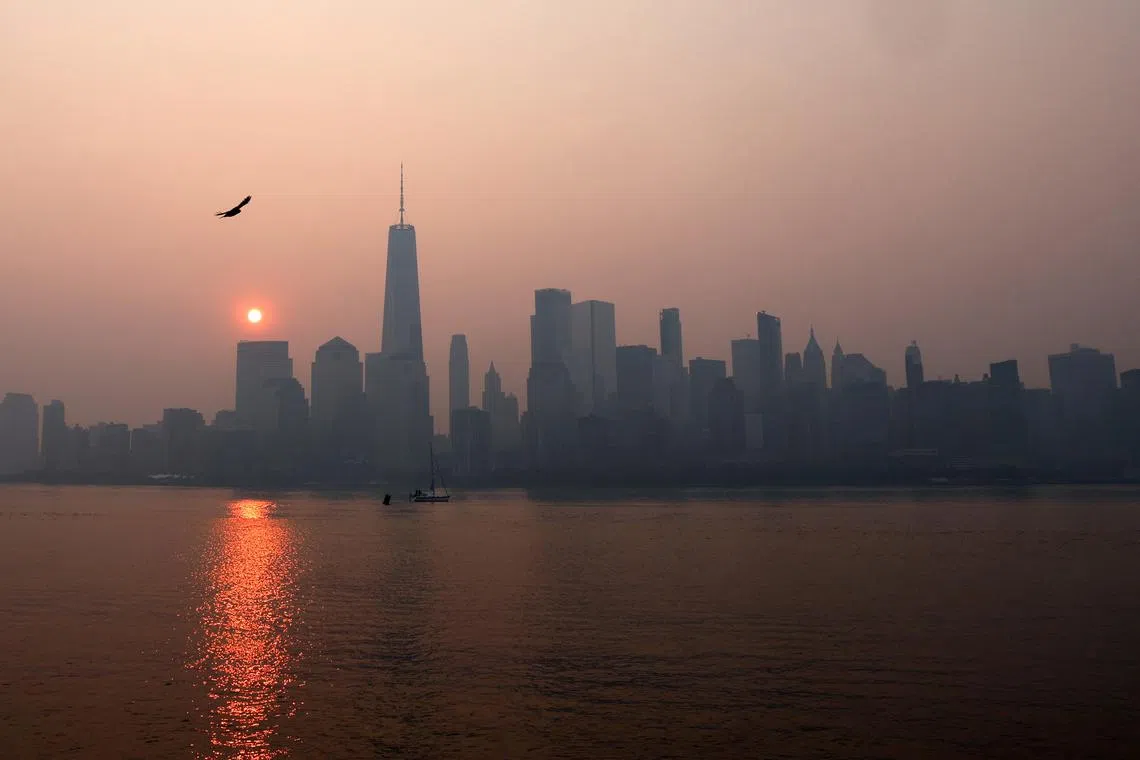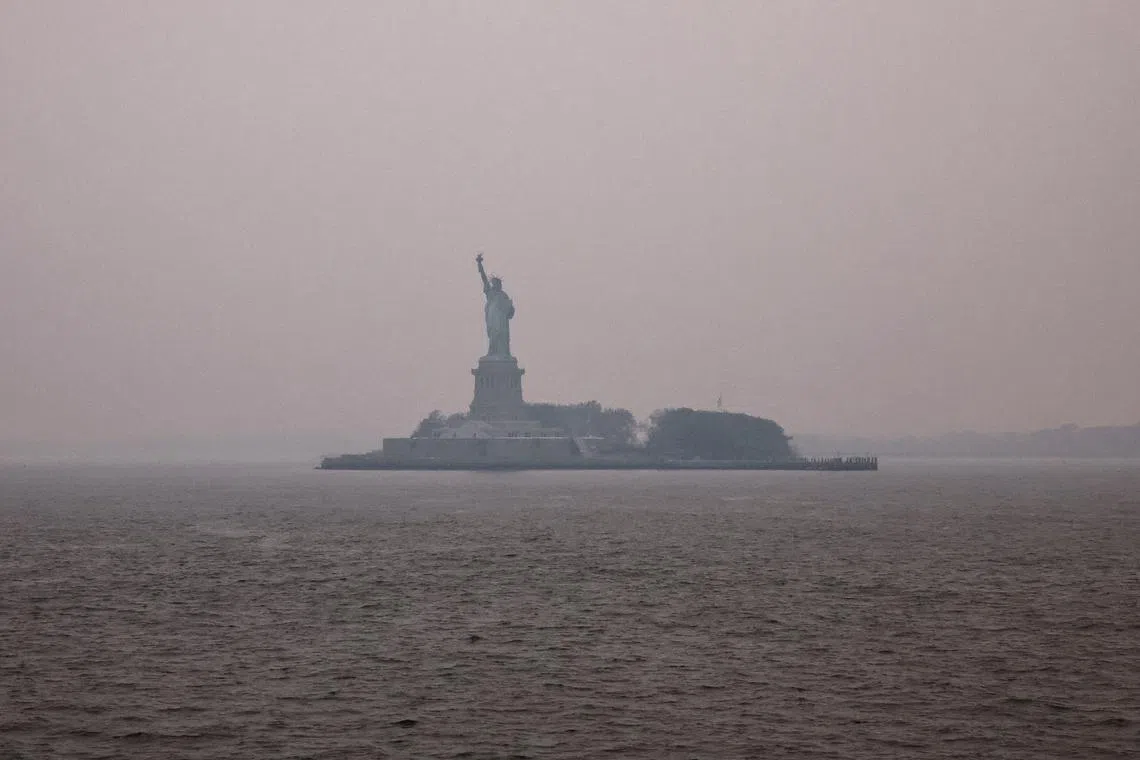New York City could be in for a smoky summer as Canada’s wildfires rage
Sign up now: Get ST's newsletters delivered to your inbox

New York City on Wednesday afternoon suffered under the worst air quality of any major city on Earth.
PHOTO: REUTERS
Follow topic:
NEW YORK – This week is just the beginning of what could be a long, smoke-filled summer in North America – and the start of a new seasonal pattern made possible by climate change.
The flames that have scorched Canada for weeks, driving thousands from their homes in regions along both coasts, have pumped plumes of caustic smoke south across some of the most densely populated areas of the United States.
Many of the 436 wildfires raging right now, according to the latest numbers from Canada’s Wildland Fire Information System, ignited either before or in the very earliest days of what is normally a busy season for Canadian fires.
June is often the worst month, said Dr Brendan Rogers, a scientist at the Woodwell Climate Research Centre in Massachusetts who studies boreal forest fires. Canada is seeing snow that melts out faster in the spring, he said, allowing for an earlier start to the burning season.
But an early start does not mean a swifter end.
Natural Resources Canada’s outlook calls for “well above-average” risk of outbreaks from British Columbia to the Ontario-Quebec border throughout June, and an above-average risk in most of the North-west Territories, the remainder of Quebec, a large part of Labrador and the Maritime Provinces.
Most of Canada remains at above-average risk through August. If the forecast bears out, the country will not begin to see much relief until September, and even then, large parts of British Columbia, Alberta, Saskatchewan and Manitoba will have a well above-average risk.
It’s just too warm
“Why is this happening? May was a record warm month across Canada,” said Dr Daniel Swain, a climate scientist at the University of California, Los Angeles. “There are links between record warmth and climate change.”
In all, 2,305 fires have consumed about four million hectares across Canada, making it the worst fire season in the country’s history, according to Prime Minister Justin Trudeau.
The resulting thick plumes of smoke pouring south into the US North-east has created some of the worst concentrations of air pollution in the region since 1999, according to AccuWeather. Air quality alerts in the US stretched as far west as Indiana and Michigan and as far south as South Carolina.
Parts of at least 15 US states have been affected so far.
Tuesday was the third-worst day of wildfire pollution in US history, according to Stanford University’s Environmental Change and Human Outcomes Lab.
New York City on Wednesday afternoon suffered under the worst air quality of any major city on Earth.
Across the Hudson in New Jersey, Governor Phil Murphy called the sooty skies “evidence of the intensifying climate crisis”.
When the wind shifts
Wildfire smoke is a mix of gases and particles from burnt trees, buildings and whatever else the flames consume, according to the US Centres for Disease Control and Prevention (CDC).
It can “make anyone sick”, the agency warned, but people with asthma, pulmonary or heart disease, or who are pregnant, young or elderly are especially vulnerable.
Among the symptoms are an elevated heart rate, headaches, wheezing, coughing and fatigue. Paper masks that became a staple during the Covid-19 pandemic would not filter out wildfire smoke, according to the CDC. N95 and P100 respirators are needed, and the best method is avoiding smoke.
New York could be spared in coming days as the winds shift. But what should give the densely populated US North-east pause is that fires across Quebec have been burning for weeks – only a change in wind direction earlier this week sent smoke billowing through Manhattan streets. With little to stop Canada’s raging fires, this could just be the first of many episodes that plague the region this summer whenever the wind shifts back.
Of course, climate change
Climate change has spurred on hotter, drier conditions around the world that have lengthened fire seasons in many regions, including California, Europe and Siberia.
Changes to the climate have put more energy into the atmosphere, which means severe lightning storms are happening much further north.
When Dr Rogers first began exploring the tundra, he did not need safety training for lightning. Now, such knowledge is crucial.
“The unfortunate part is we are locked in, for some extended time, to continued warming with worsening fire seasons,” he said.

Tuesday was the third-worst day of wildfire pollution in US history, according to Stanford University’s Environmental Change and Human Outcomes Lab.
PHOTO: REUTERS
Dr Rogers has found fires increasing across the boreal forests and tundra of Canada and Alaska as snow melts earlier. The blazes cause the permafrost to melt, releasing more greenhouse gases into the atmosphere in a dangerous feedback loop. Black carbon from the fires themselves ends up landing on ice sheets in Greenland, spurring faster melting there.
Climate change has, without a doubt, added to Canada’s fires in 2023, Dr Rogers said.
Canada has been burning across almost the entire length of the country, which Dr Swain and other experts described as unusual. Canada is such a big place that wildfire season normally peaks at different times.
The flames started in May as large fires moved across Alberta, a western province, shutting down oil sands production and crimping Canada’s energy output. That was followed by an outbreak around Halifax,
Tale of two winters
While Canada is having a record year, the US fire season is off to a slow start.
There have been 18,403 fires that have burned about 210,000ha since Jan 1, according to the US National Interagency Fire Centre. That total does not lag far behind the 10-year average of 21,908 fires burning just over 411,000ha at this point.
The divergence between the North American neighbours is a tale of two winters.
A series of Pacific storms brought rain and snow to the western US, squelching a years-long drought throughout the region and leading to widespread flooding. The result was a slow start to fire season, said Dr Zach Tolby, manager and lead scientist at the US National Oceanic and Atmospheric Administration’s Fire Weather Testbed.
Canada, by contrast, missed out on the winter rains and rolled through spring with little additional precipitation. Several pre-summer heatwaves have already visited Canada, and large parts of its west in particular is mired in drought. That left the region susceptible to bigger, stronger fires, with a lot of smoke to fill the skies far beyond the country.
“You don’t think of New York City as a place to have wildfire-related impacts,” said Dr Swain. “Even people who don’t live in the actual wildfire zones are very much at risk from these severe smoke-pollution episodes. It is just an illustration of how wildfire impacts are not just located in places where your house burns down.” BLOOMBERG

